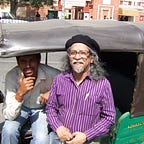Imagination and Inventions (My most amazing gadget)
The first requisite for creation is imagination, but without faith it’s probably not enough. Faith in oneself, in one’s capacity and a self-belief bordering on
egotism. One of Tagore’s favourite quote is : Faith is the bird that feels the light and begins to sing when dawn is still dark. Our present day rappers making impromptu rhymes are comparable to the old poets who went around and making up and reciting epics to crowds in market places, extempore. The same talents and qualities are involved. What chutzpah!
Here I will concentrate on machines and inventions. Most inventions occur almost by happenstance. People have noticed that wood floats, this gives them the idea of making a boat. One of the biggest invention, the wheel, was an easy one. Woodcutters have seen logs rolling down a hill, and probably began by making a toy for their kids. Then suddenly the idea for a cart flashes in. Faraday found that magnetism in motion could create electricity, and deduced that electricity could produce motion, so the motor was born. The inventors were using known facts, and their ideas evolved from these. So far, I aver, genius but no great leap of faith was required.
For many years I had thought that the bicycle came from nowhere, and marvelled at the inventor who felt the light. Then I learnt that he had not created a two-wheeled machine which could carry a rider with the help of pedals attached to the wheels. Baron Drais invented his laufmachine or
Draisine (in English), as a running gadget. The user is getting help from the wheels to go faster, but he is actually doing some form of running. One imagines that the Baron enjoyed laufing, and going downhill discovered that he could take the load off his feet and the contraption would continue free-wheeling. The bicycle as we know it was born.
For me, the most amazing invention is the zip-fastener. It is not an improvement on a predecessor. There is nothing remotely similar preceding it. One day it did not exist, and then the next it happened. At least in someone’s
head. Elias Howe. He is credited with the invention of the first sewing machine. Busy with the latter, his zip remained a blueprint for years. Perhaps, genius though he was, he lacked faith. Whitcomb Judson must have come across the sketches, and he had faith. He must have had. Who but one equipped with it, could begin to understand how two sets of metallic staples could be coaxed into clasping each other? I think of the invention as an in- vitro conception, with the good Elias providing the egg.
